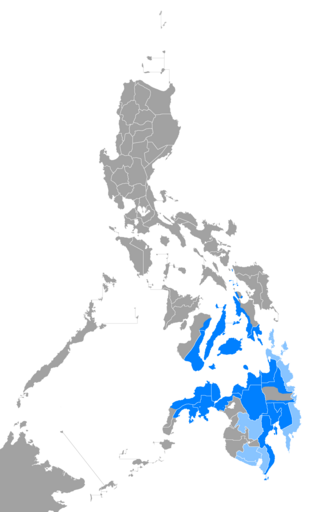| Cebuano | |
|---|---|
| Cebuan | |
| Bisayâ, Binisayâ, Sinugbuanong Binisayâ, Sebwano/Sinebwano | |
| Native to | Philippines |
| Region | Central Visayas, eastern Negros, western parts of Eastern Visayas, and most parts of Mindanao |
| Ethnicity | Visayans (Cebuano, Boholano, Eskaya, etc.) |
Native speakers | 20 million (2023 estimate)[1] |
Early form | Classical Cebuano (late 18th century)
|
| Dialects |
|
| Latin (Filipino alphabet) Philippine Braille Historically Badlit | |
| Official status | |
Recognised minority language in | Regional language in the Philippines |
| Regulated by | |
| Language codes | |
| ISO 639-2 | ceb |
| ISO 639-3 | ceb |
| Glottolog | cebu1242 |
 Cebuano-speaking area in the Philippines | |
Cebuano (/sɛˈbwɑːnoʊ/ se-BWAH-noh)[2][3][4] is an Austronesian language spoken in the southern Philippines. It is natively, though informally, called by its generic term Bisayâ ([bisəˈjaʔ]) or Binisayâ ([bɪniːsəˈjaʔ]) (both terms are translated into English as Visayan, though this should not be confused with other Bisayan languages)[a] and sometimes referred to in English sources as Cebuan (/sɛˈbuːən/ seb-OO-ən). It is spoken by the Visayan ethnolinguistic groups native to the islands of Cebu, Bohol, Siquijor, the eastern half of Negros, the western half of Leyte, and the northern coastal areas of Northern Mindanao and the eastern part of Zamboanga del Norte due to Spanish settlements during the 18th century. In modern times, it has also spread to the Davao Region, Cotabato, Camiguin, parts of the Dinagat Islands, and the lowland regions of Caraga, often displacing native languages in those areas (most of which are closely related to the language).[5][6]
While Tagalog has the largest number of native speakers among the languages of the Philippines today, Cebuano had the largest native-language-speaking population in the Philippines from the 1950s until about the 1980s.[7][failed verification] It is by far the most widely spoken of the Bisayan languages.[8]
Cebuano is the lingua franca of Central Visayas, the western parts of Eastern Visayas, some western parts of Palawan and most parts of Mindanao. The name Cebuano is derived from the island of Cebu, which is the source of Standard Cebuano.[5] Cebuano is also the primary language in Western Leyte—noticeably in Ormoc. Cebuano is assigned the ISO 639-2 three-letter code ceb, but not an ISO 639-1 two-letter code.
The Commission on the Filipino Language, the Philippine government body charged with developing and promoting the national and regional languages of the country, spells the name of the language in Filipino as Sebwano.
- ^ "Population Projection Statistics". psa.gov.ph. 28 March 2021. Archived from the original on 26 December 2023. Retrieved 20 March 2024.
- ^ Cebuano on Merriam-Webster.com
- ^ Cebu on Merriam-Webster.com
- ^ Columbia Encyclopedia
- ^ a b Cite error: The named reference
Wolff 1972was invoked but never defined (see the help page). - ^ "Cebuano". Ethnologue. Retrieved 6 September 2018.
- ^ Ammon, Ulrich; Dittmar, Norbert; Mattheier, Klaus J.; Trudgill, Peter (2006). Sociolinguistics: An International Handbook of the Science of Language and Society. Vol. 3. Walter de Gruyter. p. 2018. ISBN 9783110184181.
- ^ "Language Specific Peculiarities Document for Cebuano as Spoken in the Philippines" (PDF). Linguistic Data Consortium. 12 January 2020.
Cite error: There are <ref group=lower-alpha> tags or {{efn}} templates on this page, but the references will not show without a {{reflist|group=lower-alpha}} template or {{notelist}} template (see the help page).